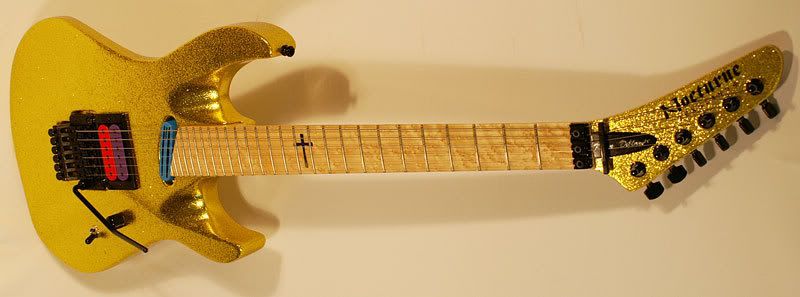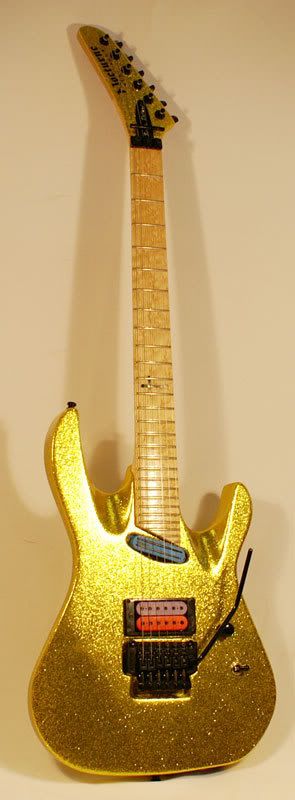
Batfink
-
Posts
505 -
Joined
-
Last visited
Content Type
Profiles
News and Information
Tutorials
Product Reviews
Supplier Listings
Articles
Guitar Of The Month
Links and Resources
Forums
Gallery
Downloads
Posts posted by Batfink
-
-
If you need a shorter block these guys do a 32mm which is about the shortest (although there could be shorter out there but i'd say it would make the bar stiff as anything) Floyd blocks
-
Go to the HFC and ask - someone will have one or, if you want a complete set, check on Ebay as Alpep has a load that he brought when the factory moved and he often list's them.
Oh, just going on from what Mattia said the machineheads are standard Schaller so you can always go and buy a Schaller branded one - no one will notice from 6 inches away.
-
I use lighter fluid quite often for cleaning stuff and have never had any compatability problems. For cleaning bodies before painting i use normal panel wipe and again i've not had any issues.
-
I would think your biggest problem is going to be the colours bleeding together through the grain.
I suppose you could dye the board black and either paint on the dots, which will obviously wear off over time, or use recon stone to inlay some dots in red.
Jem
-
?????????!!!!!!!!!!!!!!!!!!!!!!!!

-
Hi,
I'm gathering as much information as I can before starting my first guitar project. I'm UK based so if there's anyone out there who knows where to buy good quality finishes (in cans) for guitars in the UK (especially on the high street/retail park), please let me know. Some questions:
1) Can I use an acrylic paint/lacquer such as Plasti-Kote?
2) Are all car spray paints usable?
3) In the forum's experience have any brands (in cans) proved better than others?
4) Any other thoughts ideas that might help a novice builder with finishing?
 Hope there are some experts out there!
Hope there are some experts out there!Thanks
Dave
Personally:
1) - I'd avoid 'craft' type paints like the plague.
2) - Mostly, although if you've got any 'enamel' in the back of the shed leave it there. The thing to do is always use the same 'type' of paint, don't try to mix cellulose with acrylic with enamel with blah blah blah...... Saying this you can overcoat a cellulose colour coat with an acrylic clear coat but not the other way round. If you're buying fresh simply make sure it's all the same paint type and always test on a scrap piece first.
3) - Professional one's - i'll re-iterate in a second.
4) - Hey, don't finish before you start

You could wander into your local Halfords and use their off the shelf car range - it's all single part acrylic nowadays so easy to use but the solid content is very low meaning that you'll have to put a lot of coats on to get any depth at all. I'd suggest going to your local automotive paint factors as firstly, they'll be able to stuff just about any colour you want into an aerosol and secondly the solid content tends to be much higher meaning you'll use less paint.
Jem
-
You can use kite rod tubes. They're more flexible than the square rods, but probably achieve similar results. I've used 6 mm tubes --bought them at the sporting goods store, cost me 5 euros for a 1.5 meter rod.
I'd wondered about this a number of times as i've got 5/6 length's of 3mm solid x 1.5 metre hanging around. Hmmm....think i'll get some cheap softwood and have a play as, as you stated, the stuff's a tenth of the price from a kite shop compared to anywhere that has the word 'guitar' in it's business title.
-
theres this place - carbonology - they do actual rods, but its the same thing. very reasonable prices too
Both Al and myself were actually after the 5mm square section's and Carbonology doesn't do them anymore.
-
I was reading about using an amalgamator for silver but is it at all possible to use that with copper?
I think this guy is thinking of a 'liquid' inlay by mentioning 'amalgamator' in his post.
If this is the case, although i'd always go the 'traditional' route, seek out 'inlace' at a woodturners - that'll
give you the look you're after.
Jem.
-
Ask Here
Many of the guys on this UK based forum are on here but you may get a quicker answer if you post on there.
I have thought of using Rustins plastic coating, but as yet have not.
Their Danish oil is nice for the fretboard tho
Thanksmate. I will.
Appreciated.
spoke with the people at Rustins and they tell me all their products are compatible. Do you think mixing a dye with a weakened solution of the lacquer to create the aged, yellowed top and faded red burst finish would work before using the lacquer neat for the final top coats?
Here was my plan after grain filler:
1. apply a thin lacquer coat overall
2. apply a thinned lacquer, yellow coat to the top
3. apply a thinned laquer red burst
4 apply the top laquer overall
5. buff and finish
Sound OK?
Here's where I got my idea from:
http://www.setchellguitars.co.uk/ant/blog/?page_id=23
------------------------------------------------------------------------------------------------------------------------------------------------
Gosh,
Ermmm....(Ant) Setch(ell) actually replied to your first post, might be an idea to PM direct if Rustins is the way you want to go.
And yes, lots of us from the UK have finishing experience, thank you very much, but as stated not with Rustins but with either Nitro or 2K which is a whole different ball game.
Jem
Nocturne Guitars
-
Well, don't worry about my hack of a self. The only work I get is through word of mouth anyhow...makes me wonder why I'm shelling out money for a domain and web host.

Me too !
-
Juts to muddy the waters, I usually drill afterwards. Either way works, and I like not having finish and polishing gunk ending up in the holes which will need clenaing out later... usually with a drill

Touché
 I know where you're at with 'gunk' cleaning, i use bushing reamers rather than a drill but in the first place i'm just mindfull of scratching something hence drilling first and as you say, either way will work, it's just a hole after all.
I know where you're at with 'gunk' cleaning, i use bushing reamers rather than a drill but in the first place i'm just mindfull of scratching something hence drilling first and as you say, either way will work, it's just a hole after all.On the original post: the 'traditional' medium would be cellulose and i suppose the most revered of that would be Behlen's Behlen's UK site although with nitro you do have the 'checking' issue but that's 20 years down the line. Me, nowadays i just use automotive cellulose (christ knows what the difference is) or 2pack acrylic automotive paint if i'm in a hurry and need a fast build with quick cure times.
Jem
-
Drill before you paint, doing it afterwards just begs for a disaster.
As for paint there's a myriad of places over here just depends on:
1)...how you're going to paint - brush, spray can or spray gun ?
2)...what you want to use - cellulose, 2pack acrylic, 2pack poly, anything you can get your hands on ?
There's a pinned post EU suppliers which lists all the usual suspects plus don't forget your local paint factors.
Jem
-
Neck joint... Dunno what angle it is... it doesnt matter, it works, thats all i gotta know

Probably the most common sense neck angle quote i've ever heard !
Jem
-
Most of Andy's best-known guitar work was recorded with nothing more than a bone-stock Strat, with few exception. Just need a nice clean amp and a good set of fingers to nail that tone.
I think you'll find that Hamer Prototype's featured quite heavily - which is the guitar the original poster's on about.
Unfortunatley there isn't a schematic on the HFC for the Prototype so i can't help in how it was wired.
Jem.
-
Melvyn nor his publishers have made this available as an ebook but you can dowload THIS as an ebook which most people rate as highly.
-
Hiya
I know that the common answer is to use a hard wood shim (i presume mahogany or maple)
but I don't have a source for this (any ideas in the UK would be appreciated)
craig
PM me an address, i've got a sackfull of offcuts !
Jem
-
Hmmm....seems a bit quiet after last month's landslide of entries so i'll
put this up for the shredders amoungst you....you may want to turn your
monitor's brightness down for this one !
Nocturne NC1-KD
Body: Alder 2pc
Neck: 3pc rock maple / R2 nut
Fingerboad: Birdseye
Inlay: Tahitian pearl
Finish: Yellow metalflake in nitro
Hardware: Schaller all the way
Pickups: Specially wound by Steve Blucher at Dimarzio for the owner Kevin Dillard



And the owner with his new toy:

Jem
-
Yep, well that's how i do it anyway.
Jem
-
Quick questions on the same topic, related to the Stewmac Hot Rod and Martin Style (aluminum U channel).
1. Does the end of the truss rod (heel side) needs to be anchored? Or it just butts again the end of the channel?
2. Is it ok to have a gap between the truss rod and the fingerboard? Or is it absolutely necessary to add a fillet?
The Martin style has a flat top. Can the fingerboard be glued directly on it?
Thanks!
1...no, both of these are integral with themselves and are not anchored in the 'traditional' way.
2...i've used both and have never put a fillet over the top of either - although i'm not saying people don't.
As for gluing the U channel to the fingerboard - i've always left 3 > 4mm (1/8 > 3/16"ish) around the U channel clear of glue to ensure the neck moves when you adjust it rather than it popping the fingerboard off at the first turn.
Jem
-
Flat, don't bend it.
jem.
-
PM me if Doug can't help.
Jem
-
Although Touchstone's are one of the longest established and the chances are whatever you buy will be of good quality as Rich said, mail Neil or Tony for some pics or best call is go down and choose yourself in person.
Jem
-
I've used Schaller's for about 17 years and are my Floyd of choice for new builds.
Jem

Anyone Any Opnions On These?
in Solidbody Guitar and Bass Chat
Posted
Also of concern is the thickness of the material used by far east inlayers - it's much thinner than we're used to using and my major concern would be putting something like a 9" radius on one of those boards and going straight through the inlays near the sides - not very amusing !